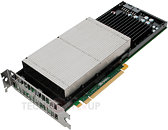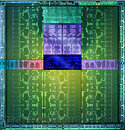- Joined
- Oct 9, 2007
- Messages
- 47,884 (7.38/day)
- Location
- Dublin, Ireland
| System Name | RBMK-1000 |
|---|---|
| Processor | AMD Ryzen 7 5700G |
| Motherboard | Gigabyte B550 AORUS Elite V2 |
| Cooling | DeepCool Gammax L240 V2 |
| Memory | 2x 16GB DDR4-3200 |
| Video Card(s) | Galax RTX 4070 Ti EX |
| Storage | Samsung 990 1TB |
| Display(s) | BenQ 1440p 60 Hz 27-inch |
| Case | Corsair Carbide 100R |
| Audio Device(s) | ASUS SupremeFX S1220A |
| Power Supply | Cooler Master MWE Gold 650W |
| Mouse | ASUS ROG Strix Impact |
| Keyboard | Gamdias Hermes E2 |
| Software | Windows 11 Pro |
Specifications of NVIDIA's Tesla K20 GPU compute processor, which was launched way back in May, are finally disclosed. We've known since then that the K20 is based on NVIDIA's large GK110 GPU, a chip never used to power a GeForce graphics card, yet. Apparently, NVIDIA is leaving some room on the silicon that allows it to harvest it better. According to a specifications sheet compiled by Heise.de, Tesla K20 will feature 13 SMX units, compared to the 15 available on the GK110 silicon.
With 13 streaming multiprocessor (SMX) units, the K20 will be configured with 2,496 CUDA cores (as opposed to 2,880 physically present on the chip). The core will be clocked at 705 MHz, yielding single-precision floating point performance of 3.52 TFLOP/s, and double-precision floating point performance of 1.17 TFLOP/s. The card packs 5 GB of GDDR5 memory, with memory bandwidth of 200 GB/s. Dynamic parallelism, Hyper-Q, GPUDirect with RDMA are part of the new feature-set. The TDP of the GPU is rated at 225W, and understandably, it uses a combination of 6-pin and 8-pin PCI-Express power connectors. Built in the 28 nm process, the GK110 packs a whopping 7.1 billion transistors.


View at TechPowerUp Main Site
With 13 streaming multiprocessor (SMX) units, the K20 will be configured with 2,496 CUDA cores (as opposed to 2,880 physically present on the chip). The core will be clocked at 705 MHz, yielding single-precision floating point performance of 3.52 TFLOP/s, and double-precision floating point performance of 1.17 TFLOP/s. The card packs 5 GB of GDDR5 memory, with memory bandwidth of 200 GB/s. Dynamic parallelism, Hyper-Q, GPUDirect with RDMA are part of the new feature-set. The TDP of the GPU is rated at 225W, and understandably, it uses a combination of 6-pin and 8-pin PCI-Express power connectors. Built in the 28 nm process, the GK110 packs a whopping 7.1 billion transistors.


View at TechPowerUp Main Site
Last edited:





 and3.52 TFLOP/s normal. D.P.1.17 TFLOPS/s.
and3.52 TFLOP/s normal. D.P.1.17 TFLOPS/s.
 )))
)))



